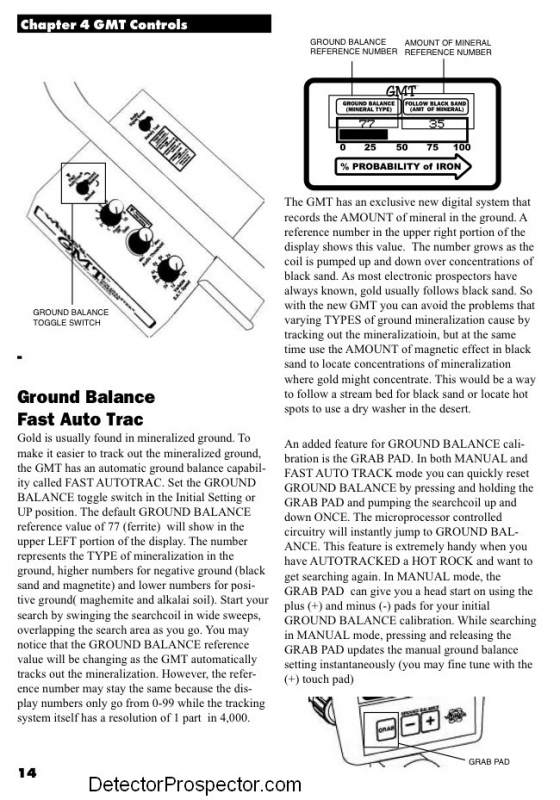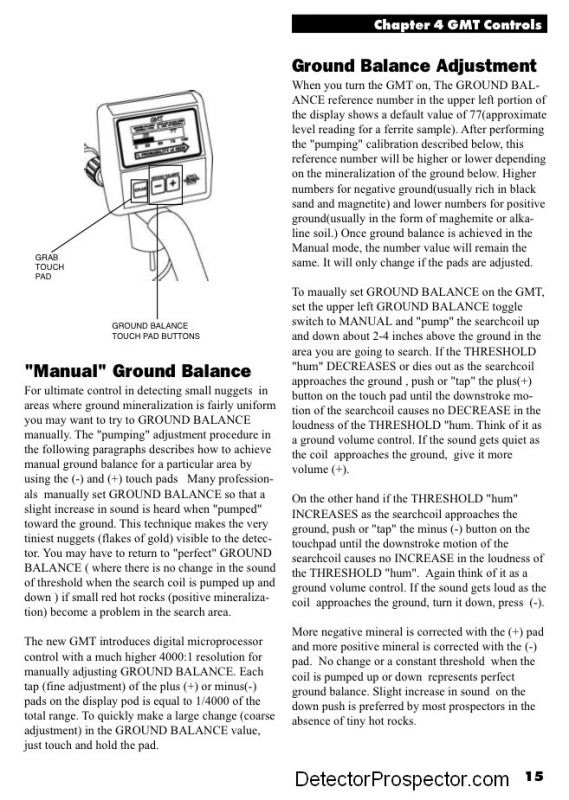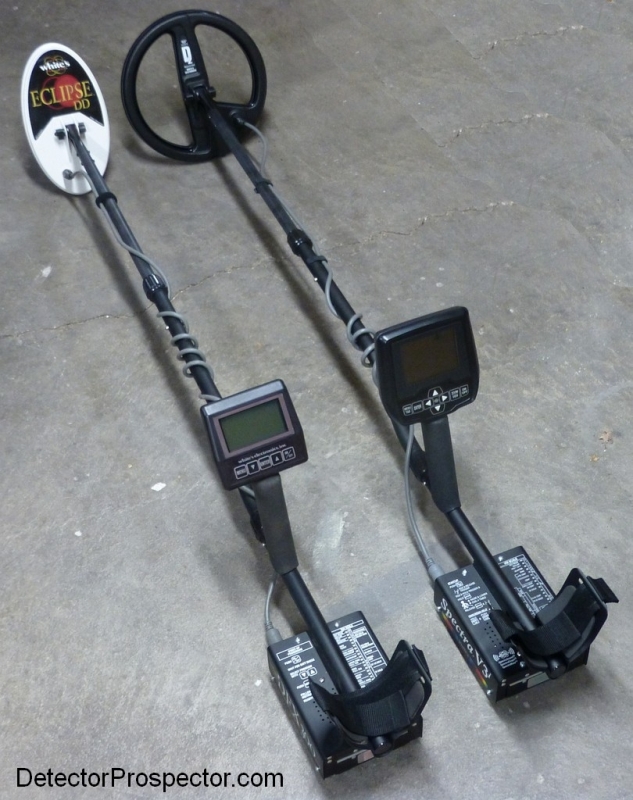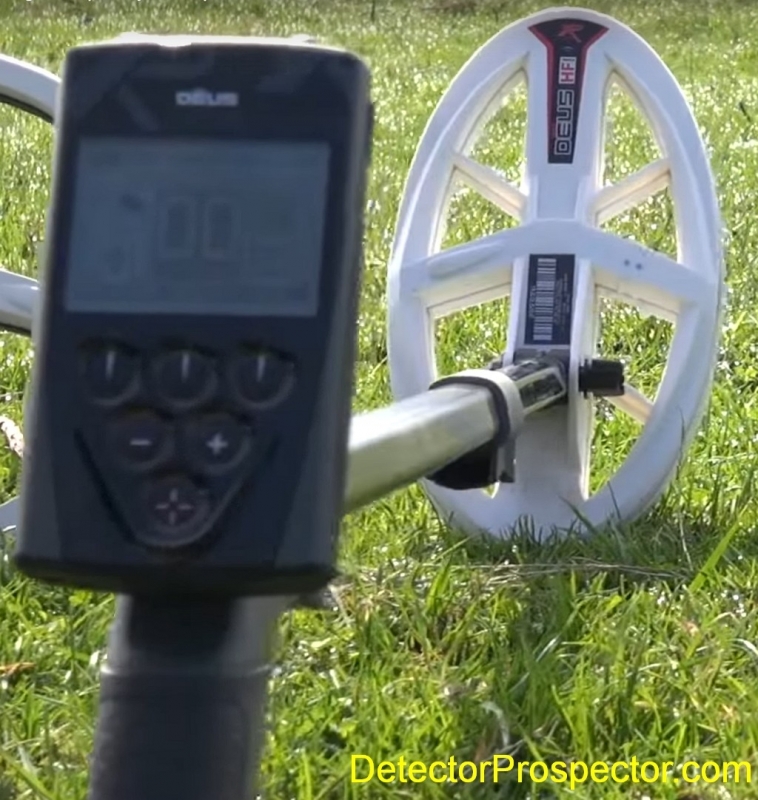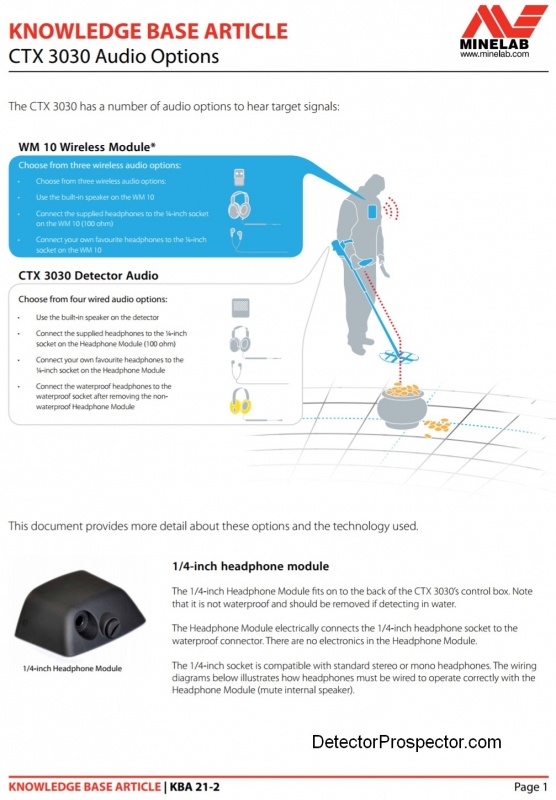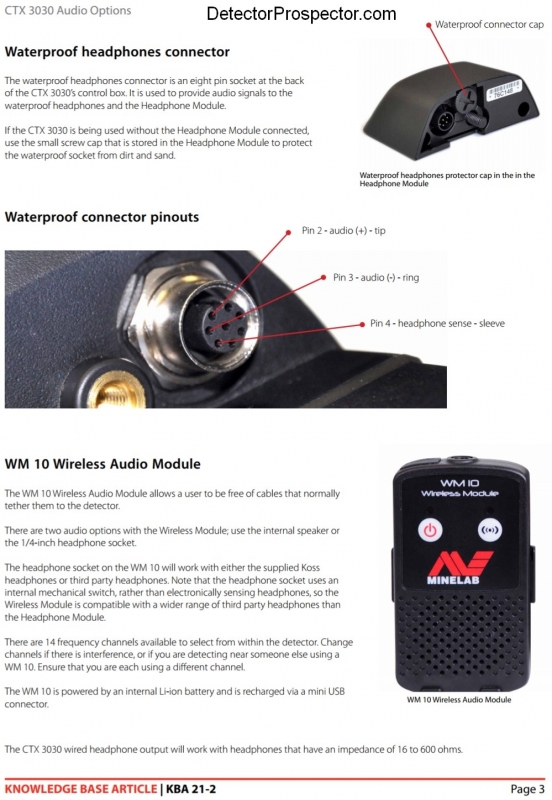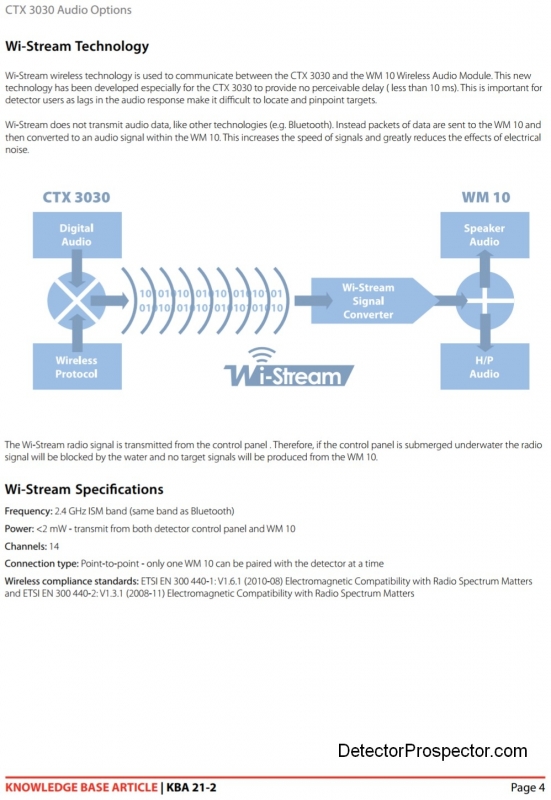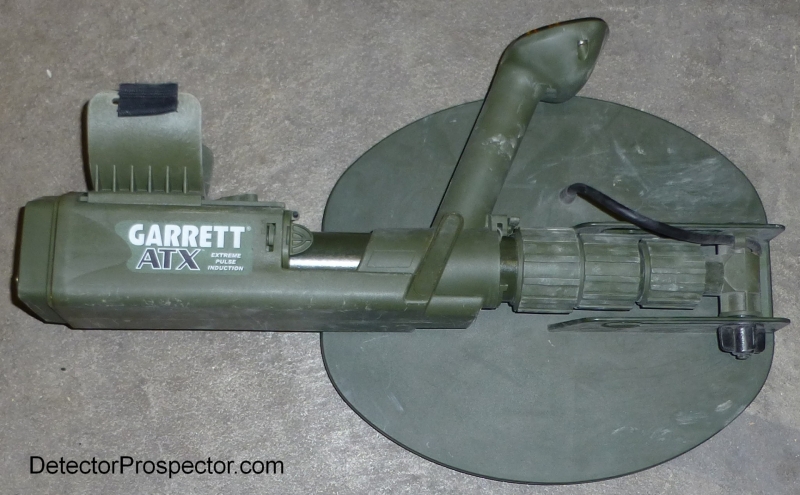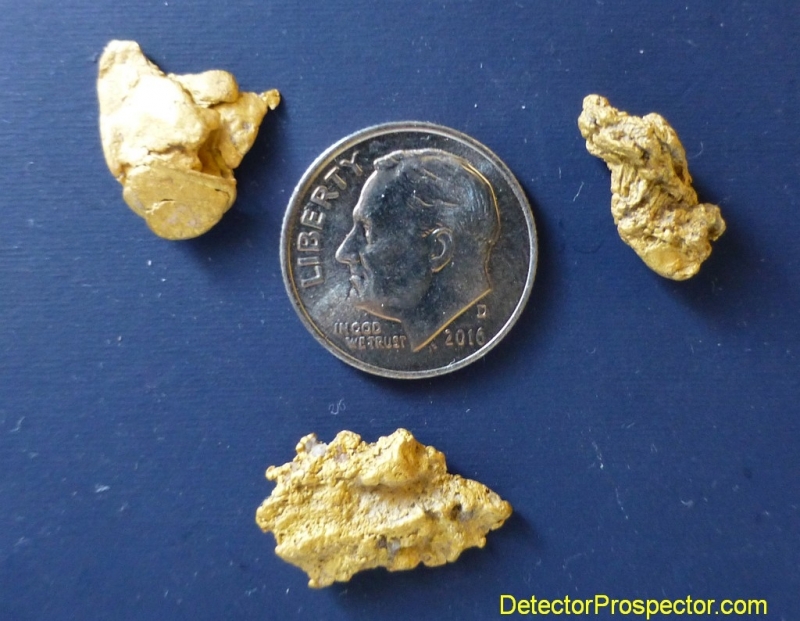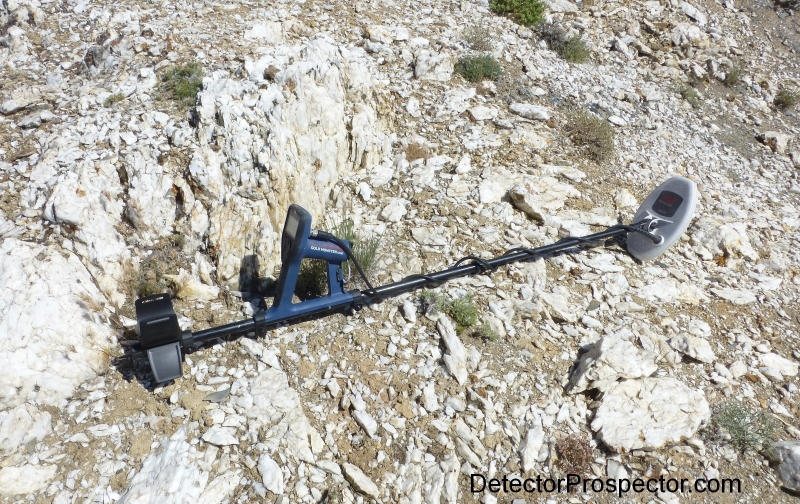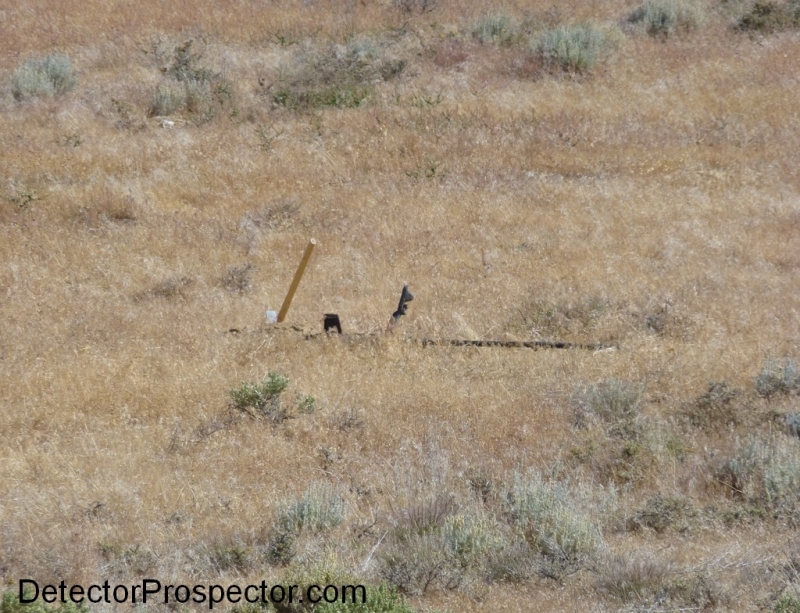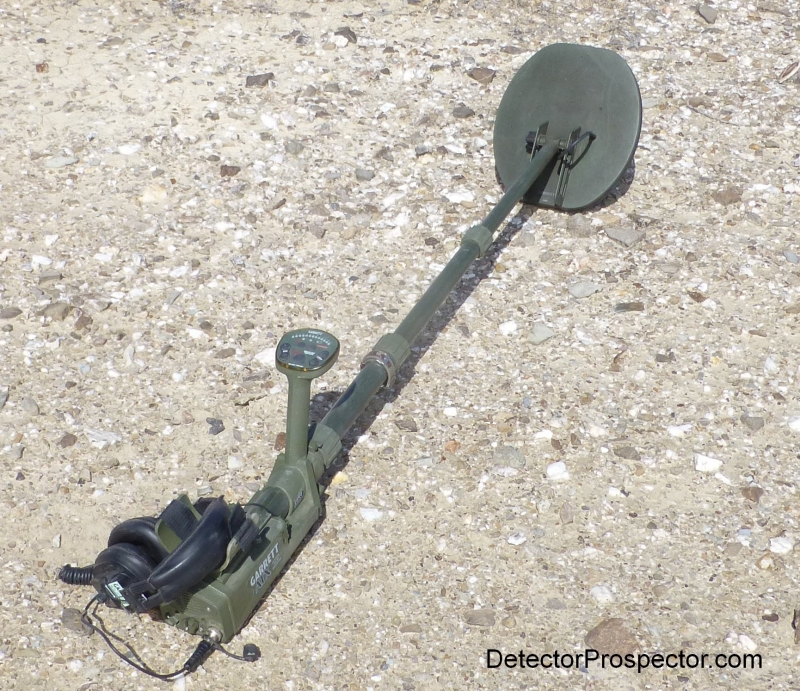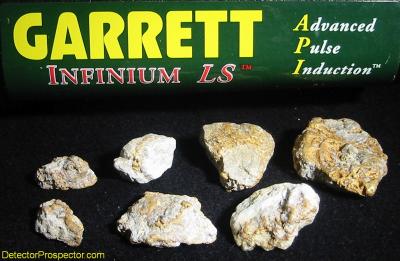-
Posts
19,761 -
Joined
Content Type
Forums
Detector Prospector Home
Detector Database
Downloads
Everything posted by Steve Herschbach
-

White's Dfx Versus V3i On Gold
Steve Herschbach replied to Steve Herschbach's topic in White's Metal Detectors
Welcome to the V3i rabbit hole! Yeah, track speed, SAT, recovery speed, filters - all matter and interact. -

White's Dfx Versus V3i On Gold
Steve Herschbach replied to Steve Herschbach's topic in White's Metal Detectors
The last few posts I made give some examples of why a manual offset either positive or negative is sometimes desirable as opposed to a "perfect" ground balance. Tracking or even ground grab gives you what the engineers think is the best ground balance. However, when prospecting I usually run slightly positive. If I ground grab a Gold Bug Pro, I get a neutral ground balance. But the first thing I do is hit the manual + button twice, which makes the detector give a slight response as the coil approaches the ground, my desired setting. It may be the V3i in Locktrac but punched up 1 or 2 points via the offset will produce better results on the tiniest gold targets. -

White's Dfx Versus V3i On Gold
Steve Herschbach replied to Steve Herschbach's topic in White's Metal Detectors
V3i does have a track speed setting. Owners Manual page 34: "Speed – Selects the speed or aggression of Auto Tracking. Press ARROW Left & Right to select the speed of Auto Tracking. Excessive ground tracking can be as bad for performance as insufficient ground tracking. A speed that keeps up with progressive ground changes is desired. A setting that adjusts significantly when passing over slight (spotty) ground imperfections can cause instability and errors. Ideally select a speed that keeps up, yet doesn’t overcompensate for every unusual rock." Part of the problem is this is a multi frequency detector and so ground tracking is probably a much more complicated thing than it is with a single frequency detector. Plus, the GMT and MXT have a specific prospecting intent, whereas with the V3i prospecting was probably last on the engineer "worry list". Also from Link deleted since Findmall Forum update broke all old links "Tracking Speed, lower numbers equals slower track speed. The V is always tracking as long as auto track is on. The control adjusts the limit of how much it can track at one time. So, (example - numbers are not correct at all - just to give you an idea what's going on), say you have a ground signal that is off by 10000 from where ground really is. If you have your setting at 10, the detector would track at the most by 20 at one sample. If your ground was off by only 8, then it would adjust by 8 as that's less than the limit. But at 10000, it will be limited to 10 at that one data sample. Whereas, a setting of 20 will track at most by 40 per data sample. There are a lot of factors that come into play on how tracking is adjusted - whether it has seen a target recently, how fast the ground is changing, the user adjustable track speed, how close the ground setting is to the current ground. If the ground setting is close to the current ground, it will track to the current ground faster than if the current reading is far away (might be a target and don't want to track to targets)." -

White's Dfx Versus V3i On Gold
Steve Herschbach replied to Steve Herschbach's topic in White's Metal Detectors
I see that White's describes the "ground grab" method in the V3i manual as being "Manual Ground Balance" so you have your proof there! I guess it is a manual method compared to tracking but it is still a ground grab methodology. The GMT for a long time was my only and best example of a detector that does all three basic methods. 1. Tracking 2. Ground Grab (or Track & Lock) 3. Manual and for sake of accuracy a fourth method exists.... 4. Factory Pre-Set Click images for larger versions.... -

White's Dfx Versus V3i On Gold
Steve Herschbach replied to Steve Herschbach's topic in White's Metal Detectors
The V3i is a bit unique as it basically offers either automatic ground tracking and a "track & lock" or ground grab system. However, since White's removed the DFX manual ground balance (G.E.B.) settings from the V3i, they did see fit to add a "Lock Offset" function. Some automatic tracking systems (like DFX and V3i) feature a "Track Offset" function that allows you to create a positive or negative bias to be applied to the tracking results. V3i added a "Lock Offset" which is basically a manual ground balance control. The difference is it gets the base setting via the ground grab, and then just adjusts up or down from there. "Offset – Selects a slightly + or – ground balance and tracking setting point to enhance ground rejectionand target responses. Typically a “+” offset is used to reduce ground mineral responses and enhance target signal responses (particularly small size targets) in extreme ground types. More rarely “-“ offset may be used to enhance the response of iron oxides in a low iron ground matrix, for example stony iron meteorites in a ground matrix consisting of ice/snow." -

White's Dfx Versus V3i On Gold
Steve Herschbach replied to Steve Herschbach's topic in White's Metal Detectors
Basically, no. The DFX has a D.C. Phase function and the V3i the Ground Probe, but neither is as simple as say the Gold Bug Pro in all metal mode, where the big number on screen is a live ground phase number. -

White's Dfx Versus V3i On Gold
Steve Herschbach replied to Steve Herschbach's topic in White's Metal Detectors
Deft Tones, this is all no big deal, just me "self teaching" by looking up stuff for my own use and then posting about it. Manual ground balance is rarely needed by most people but is firmly entrenched in the prospecting world. In the end, all metal detector performance comes down to the efficiency and accuracy of the ground balance. A fine manual tune was once considered essential for gold prospecting but honestly that is not so true any longer as better tracking systems come online. -

White's Dfx Versus V3i On Gold
Steve Herschbach replied to Steve Herschbach's topic in White's Metal Detectors
The old MXT was of course just tracking or "track and lock". The addition of the ground grab button on later MXTs was a nice usability enhancement but really does the same thing in the end. -

White's Dfx Versus V3i On Gold
Steve Herschbach replied to Steve Herschbach's topic in White's Metal Detectors
That's correct John. I think we are thinking same thing and tripping over terminology. The F75, GBP, etc. track internally and display the current tracking as the ground phase number. This is only displayed however and is not engaged or used until locked in via the ground grab button. -

White's Dfx Versus V3i On Gold
Steve Herschbach replied to Steve Herschbach's topic in White's Metal Detectors
No, that is ground grab. Manual ground balance has the ability to adjust up or down via a control. There are three basic methods: GMT - Ground tracking OR ground grab OR manual ground balance MXT - Ground tracking OR ground grab V3i - Ground tracking OR ground grab With automatic tracking a detector adjusts to the ground on the fly. Ground grab is accomplished via either the "track and lock method" or via a "Ground Grab" button. Tracking and then locking simply sets the balance at the last tracked setting. Ground grab usually relies on a detector tracking internally and then "grabbing" whatever that internally tracked number is and locking it into place via a button or switch. Machines like the F75 and Gold Bug Pro, to name a couple, do track internally at all times, which is where the ground phase display comes from. Hitting the ground grab button on either unit locks the current tracked number in as the current fixed ground balance setting. Other machines ground grab by temporarily engaging a tracking circuit when a button or switch is activated. Manual ground balance is pure manual control. Classic example is the Gold Bug 2 ground balance (ground reject) knob. -
I have been bouncing back and forth between the White's DFX and V3i for many years. In theory the switch to V3i should be a no-brainer. However, the original Vision model I got had bad EMI issues in Anchorage, Alaska, especially with buried power lines. When the V3i came out I tried again with no joy. When I moved to Reno I tried again, and EMI was less a problem. The next issue is the main reason I have a DFX is to run a BigFoot coil. Most coils need to be tuned for the specific detector operating frequency. The BigFoot is tuned for 3 kHz and 15 kHz especially for the MXT/DFX series. My BigFoot works well enough in V3i 2.5 kHz and 7.5 kHz single frequency modes. However, in 22.5 kHz single frequency mode or in three frequency mode the target id (VDI) numbers all skew very high (they tripled on the last V3i that I had). This more or less limited the BigFoot to being used only in 7.5 kHz mode on the V3i where I would generally prefer to use 22.5 kHz single frequency mode. The coil runs just fine on the DFX in 15 kHz mode so after lots of back and forth I finally settled on the DFX. The DFX has weaknesses however. The DFX always transmits a combined dual frequency waveform. When single frequency mode is chosen, the machine still transmits the same waveform optimized for dual frequency use, but simply ignores half the return signal to process either the 3 kHz portion or the 15 kHz portion. The transmit waveform is not optimized for single frequency and so some punch is lost compared to a dedicated single frequency machine like the MXT. The V3i in single frequency mode actually modifies the transmit waveform for use at the single frequency. It is still not quite as efficient as a dedicated single frequency detector, but a big improvement over the DFX way of doing things. The V3i also adds transmit boost capability, that can bring that last little bit of lost performance as compared to a dedicated single frequency detector. The lost efficiency shows up more as shorter battery life than actual lost performance. Second, the DFX while in multi frequency mode is always locked into "Salt Mode" for saltwater beach operation, effectively tuning out the salt range. This unfortunately means that small gold capability is degraded in DFX dual frequency mode. The V3i allows the salt mode operation to be deactivated while in multi frequency mode, allowing for better small gold performance while in MF mode. The closest the DFX can get is to run in a single frequency mode, which turns off the dual frequency salt compensation. But now you are back to running a less optimized single frequency mode as compared to the V3i in single frequency mode. Long story short there are too many benefits and neat features on the V3i that I have been denying myself due to my desire for BigFoot compatibility. The fact is I normally run the BigFoot in 15 kHz single frequency mode on my DFX for a little extra gold hots. However, after some thought I have decided the V3i running at an optimized 7.5 kHz is likely just as good if not better than the DFX running a "soft" 15 kHz. So I did talk myself into a new V3i recently. In theory the V3i at 22.5 kHz should be a decent nugget detector, but you rarely hear of it being used as such. Part of that is a ground balance issue. The DFX and V3i tracking systems really are not up to working that well in heavily mineralized ground. The DFX does offer a normal manual ground balance mode with both a coarse and fine adjust, although you have to dive into the menu to access it - not so handy for making constant tweaks. The V3i actually has no true Manual ground balance mode. The best you can do is track and lock, as on the MXT. However, the V3i "Live Controls" can be set up to give the operator direct access to a ground balance offset that can tweak the "locked" setting up or down. That may actually be easier to access and use than the DFX version of manual ground balance but I need to play around more to find out for sure. White's DFX and White's V3i metal detectors
-

XP Deus HF Elliptical Coil Delayed Until July?
Steve Herschbach replied to Ono's topic in XP Metal Detectors
I expect I will have one of these coils next week so we will see. I can't imagine XP releasing a complete loser of a coil. Now the guy reporting the poor depth says "never mind"! http://www.treasurenet.com/forums/deus/546676-first-thoughts-review-new-xp-deus-elliptical-coil-5.html#post5464355 -
I run in auto a lot and when doing so I just leave it there with no ill effects, but switching to Manual 10 might give you a sharper signal for pinpointing small nuggets.
-

XP Deus HF Elliptical Coil Delayed Until July?
Steve Herschbach replied to Ono's topic in XP Metal Detectors
Part of my desire for this coil is that it perhaps does not beat a Gold Bug 2 but is close enough to do the trick, given it can be used to coin, jewelry, and relic hunt. But if it does well on gold but not well enough on coins etc. then you are back to needing at least two detectors (or at least two Deus coils) to get a good balance in performance. The 9" round HF coil may be the better compromise, with the elliptical tilted too heavily to the gold nugget side of the equation. -

XP Deus HF Elliptical Coil Delayed Until July?
Steve Herschbach replied to Ono's topic in XP Metal Detectors
Oh, I would not say 5" air test on a penny sounds good! I just was pointing out that out of all the coils made for the DEUS so far I would expect this one to get the least absolute depth on high conductive coins no matter the frequency. How much less remains to be seen. I think people do have reason to be concerned and perhaps hold back. This coil was delayed a couple extra months and never a word of explanation. Some kind of issue to be overcome? I don't know, but the old wisdom about not being the first kid on your block to get new detecting toys still holds true. This is not just a coil but is actually a $425 metal detector and so a lot more is going on here than just wire in a housing. The DEUS HF elliptical was designed for and is marketed as a gold prospecting coil, so how it fares in highly mineralized ground on small gold nuggets versus my GM1000, Gold Racer and Gold Bug 2 are questions at the top of my list. The 3.5" air test on a half gram nugget does not sound good either, but as always it's real world results that matter. -
Well, check those switches on the Black Widows first! However, this is a known issue with other Minelab detectors. Headphones do need to be wired properly in order to work with some models. This Minelab Knowledge Base article goes over the issue as relates to the CTX 3030. I believe the GPZ 7000 is identical in this regard. Sun Ray makes two models of Sun Ray Pro Gold headphones, the original model, and another model wired specifically to work correctly with the CTX 3030 (and other detectors also) for $5.00 more. Why not just make the one model that works with all detectors? Good question. Long story short I own two sets of the Sun Ray CTX version and they work with anything. I would tend to doubt this is the problem on the GM 1000 but figured I would mention this just in case. Click on images below for larger versions....
-

XP Deus HF Elliptical Coil Delayed Until July?
Steve Herschbach replied to Ono's topic in XP Metal Detectors
I doubt this coil would get "more depth" in absolute terms on high conductive coins. Any of the existing coils should be better choices for pulling copper and silver coins at depth. However, this coil may pull coins at two or three inches in dense trash that are missed by the other coils simply by virtue of the narrow footprint. This is a sniper coil, not a deep seeker. Same guy is quoting a 3.5" air test on half gram gold nugget running at 80 kHz. -

Some Nevada Gold Nuggets
Steve Herschbach replied to Steve Herschbach's topic in Detector Prospector Forum
I am testing the new coils, which will only mount on my stock ATX. In this case it works out better anyway as the weight actually is a benefit when trying to swing in the grass and weeds. Besides, the "boat anchor" still weighs less than my GPZ so I guess it's all relative. -
I think the swing faster thing may be misunderstood. In moaning groaning areas the only real solution previously was to slow way down. Now, you should not have to slow down as much. That's all.
-

Garrett ATX 11x13 DD Or 11x13 Mono Or 10x12 DD
Steve Herschbach replied to Jalance's topic in Garrett Metal Detectors
I have been out and about recently with the new 11” x 13” DD coil Garrett has introduced for the ATX. I have both the DD and mono versions of the new coil but so far most of my time in field has been with the DD coil although I have also used the mono. The new coils are aimed at a few issues that owners of previous ATX coils have complained about. First, the rather unique rear hinge design of the previous ATX coils that allows the detector to fold up into a particularly compact configuration. This design has two issues. As the coils age the weight tends to cause the coil to slowly sag forward. Not a huge factor but it can result in constant small adjustments to level the coil out. More important it throws the weight of the coil forward, hurting the center of balance. Again, not a huge issue, but one that becomes more apparent if you try and mow through high grass and weeds with the ATX. Finally, the original ATX coils had a tendency to catch an edge on a rock or other hard object and generate false signals when pushed to the highest sensitivity levels. Garrett came up with an ingenious fix for these issue, that both allows the coil to fold up as desired while delivering that center mount coil so many have craved. The new coil design in a fully enclosed design that has a sliding channel that lets you move the coil attachment point from rear to center or anywhere in between. You don't see something new in metal detecting very often but this really is. And it works. Here is a shot of the new coil with the old design inset into the upper right. The new design is completely enclosed. This is a benefit especially while nugget detecting as putting a full scuff cover on the old design creates a catch area for weeds, twigs, and other debris. The new design sheds debris and so is better for dry land use, but the old designs will remain the coils of choice for in water use. I was initially more excited about the mono version of the coil because of my experience with other PI detectors which often favor mono coils for overall performance. The ATX however was designed specifically around a unique Garrett DD design that modifies the overlap area of the double D design to create what is in effect a small inner coil region that is exceptionally hot on small gold. This roughly 4.5” x 5” inner coil area is nestled directly in the middle of the overall 11” x 13” area. This inner area is not visible due to the enclosed housing design but it is there and a user wants to be very aware of this fact when hunting for the smallest gold. The mono version of the coil lacks this hot inner coil area and so lacks the extra sensitivity to small gold created by the dense electromagnetic field generated there. The mono coil is actually hotter around the perimeter of the coil where the windings run but overall it is a bit less sensitive to the smallest gold than the DD coil although in theory the mono should have an edge for depth on multi-ounce nuggets. The mono coil also lacks the DD ability to engage and use the rather decent ATX shallow ferrous rejection circuit, which only works with DD coils. For these reasons I think most people will be better served by the DD version of the new 11” x 13” coil, with the mono being a better choice perhaps for those seeking some small advantage on the largest gold nuggets at depth. I own the Garrett ATX mostly because of its versatility. It is my favorite beach and in water detector due to the robust physical design combined with an ability to handle the worst combinations of salt water plus magnetic black sands and cobbles. This works very well at most western U.S. ocean and lake beach locations and at volcanic island locations like Hawaii. I actually do a bit of coin detecting with the ATX also. The ATX is also a very capable prospecting detector that complements the other detectors I have very well. The ATX can ground balance to just about anything, making it very useful in desert salt flat areas and for handling certain hot rocks that other detectors struggle with. The ferrous discrimination, while not perfect, is one of the best available in a PI detector, with the main failing being that it only works on shallow targets. It does not help for those really deep nails but is a definite aid in an area littered with surface trash. I also discovered another advantage with the ATX on a recent trip. I had been doing some prospecting for most of a week in an area that seemed like it might have good potential but with little to show for the time spent. I finally decided to fall back to an old known patch to get a little gold at least before I headed home. This year I have run into a new issue in northern Nevada. Several years of drought left areas relatively bare of grass and weeds, but extreme wet conditions this last winter really produced a bumper crop of grass in some areas. Another detector I often employ has a little larger coil than the Garrett 11” x 13” coil, and so I found it advantageous to switch to the ATX with the new coil specifically for hunting these grassy locations. It is still tough going with the ATX in this kind of stuff but it did help make it more manageable. The new center mounted coil works far better in the grass than the old rear mount design, and the enclosed housing sheds the debris that would quickly pile up on the old coil with a full scuff cover. Best of all, running the ATX full out at sensitivity 13 resulted in almost no false signals from knocking or hitting the coil on rocks or other obstructions. The new coils are at least as good if not better than other competing brands now in this regard. Instead of the careful coil control required of the old coil I could manhandle the new coil as I pleased and basically just did not have to think about the issue at all. I think the new enclosed housing combined with the new scuff covers has a lot to do with this by providing a cushioning effect of sorts. The old stock coil sensitivity to knocks at high sensitivity I think was overdone by many, as it can be dealt with by careful coil control. However, being freed of the need for careful coil control absolutely makes for a more positive prospecting experience as it frees the operator from paying as much attention to the detector. Instead, more attention gets spent just hunting naturally with the detector while paying more attention to surroundings and visible signs of gold mineralization. In my opinion for my use it actually results in a tipping point being reached. Before, I was less prone to using the ATX for prospecting because of this issue. Now, I am far more likely to employ the ATX than I was in the past with the knock sensitivity issue all but eliminated. The patch I hunted has been pretty well pounded, but I targeted a trashy location that had seen less detecting than the trash free areas, and was pleased to have not one but two nuggets turn up, one weighing 1.5 grams and the other 2.19 grams. Not small nuggets at all really – anything over a gram is a pretty decent nugget in my book. I am far from done using or reporting on these new coils and as I get more time on them in the field I will report back. Right now I am very pleased with the new DD coil in particular, and would not hesitate to recommend that anyone buying a new ATX for gold prospecting get the 11” x 13” DD as the stock coil via one of the new packages Garrett is offering. For existing owners it is a bit more complicated. I have to say that for overall depth and sensitivity I perceive there to be no real difference between the 10” x 12” DD and the 11” x 13” DD. Since a DD coil has a transmit coil and a receive coil, each just over half the size of the overall coil ,you get very little actual increase in the receiver coil size when you increase the overall coil size by only an inch. Once the new housing is taken into effect there is very little difference if any in the size of the actual coil windings involved. Long story short from a depth and sensitivity perspective I have experienced no real difference between the 10” x 12” DD and 11” x 13” DD coils. What difference there is there is so small I can’t personally recommend a person get one of these coils based strictly on that factor. For me the real benefit is the debris shedding enclosed coil housing, superior coil center mount handling, and extra resistance to false signals from coil impacts. The advantages in those regards are real and substantial and worth the upgrade for those who are troubled by these issues. The old 11” x 12” DD will probably never be used on my detector again for gold prospecting, but will be reserved for water use only. -
When I am water hunting wallet stays home. Drivers license in glove box. Key goes with me in the water. The only issue I have had is on vacation using a rental car. The have keys sometimes that have an integrated module with battery that opens and locks doors, etc. If you take those in salt water it will kill the electronics. Which I did because trying to hide keys on a vehicle in a busy tourist location - yeah, I worry somebody will see where I place them.
-

Garrett Infinium- First Impressions
Steve Herschbach replied to MontAmmie's topic in Garrett Metal Detectors
Performance of the TDI and Infinium is close, but there is no ability to manipulate ground balance on the Infinium (it's automatic tracking plus "lock") directly which is one of the things that makes the TDI different. The TDI also generates a single tone, either high or low, depending on the target. The Infinium generates a dual tone in each target, high/low or low/high. This doubles the noise in dense trash, and there is no tone suppressing switch (referred to as a conductivity switch on TDI) so you always hear it all. The bottom line is the Infinium can find the same items as the TDI but has less tuning options and the nature of its audio response make it more challenging in dense targets. The main Infinium advantages are waterproof and simplicity of operation. Garrett Infinium Tips & Tricks -
I have been doing a lot of what I call “blue sky prospecting” where I get out and hunt areas not known currently as “nugget hunting areas”. There are a number of well known areas in the western U.S. that people converge on and hunt repeatedly year after year. The attraction is that although these areas are well hunted, detectable gold is known to exist and proficient nugget hunters have a high chance of finding at least a little gold by visiting these locations. Going to areas that have no real history of producing gold nuggets with a metal detector has however a much greater likelihood of producing no finds at all. It is just the nature of exploring off the beaten path and for people with limited time it is very hard to choose to hunt an area where nobody has ever detected gold before and where you will probably find no gold as opposed to hunting known productive areas. The problem with well known areas is that they are well detected, so the best one can usually expect is to eke a few missed nuggets here and there from these places. I do have more time however to apply to the search, and so have made looking for new “patches” an integral part of my prospecting program. I seek out and hunt outlying unclaimed areas peripheral to known gold bearing areas for at least half my time in the field, falling back to known locations now and then to find at least a little gold to boost morale and help pay for beans and gasoline. Going many days at a time without finding gold takes a lot of patience but the hope is that eventually I will make an exceptional find in the form of a virgin patch that makes up for all the hours of non-productive hunting. I say non-productive, but I never come away feeling like that is the case. I always learn something, even if it is to the negative, about my detectors and the gold itself – where it is and is not found. On to the hunt. I was exploring an area in northern Nevada where quite a lot of past prospecting is apparent in the form of pits, trenches, and small prospects. Lots of quartz veins exposed and surface quartz. Nearly all the prospects looked to be "busts" where the initial trenching or pit digging was abandoned with no further work done. Some showed a little more work that indicated that there was possibly at least a little positive results - or just an overly optimistic prospector. I have pretty much abandoned day trips and "hit and run" type detecting in favor of parking my posterior in one camp location for days (at least) and methodically exploring the surrounding area. That being the case I decided to spend a minimum of three days hunting this area to see if I could scare up any sign of gold. I of course relied heavily on my GPZ 7000 for a lot of the detecting but also got in lots of hours with the Gold Monster 1000 and Garrett ATX. A lot of the ground featured shallow exposed bedrock and so depth was not the issue, and the GM1000 was great for these areas and for checking quartz around the old prospects. I did get a couple pieces of quartz that gave non-ferrous beeps. I broke one and it appears to be a copper mineral of some sort that signaled in that one. Might be the same for the other but I have to check it out still. It sounded better so I decided not to just break it but wait until I could scan it with my Falcon Gold Probe and examine it better before taking action. I was up early to beat the heat and so getting in lots of hours. Great looking ground but other than a bullet now and then nothing much to report. Sometime into the second day my GPZ started acting up. It seemed like extreme EMI and nothing I could do would make it quit. Even my last resort of a full reboot did not eliminate the noise. So I broke out my Garrett ATX that I have along for backup, which really needed doing anyway as I wanted to get more hours on the new coils. The new 11" x 13" DD coil is enclosed to shed debris, center mounted rod for better balance, and most importantly, resistance to knocks and false signals that is at least as good as my GPZ if not better. A side bonus is salt ground and hot rocks the GPZ sees I can tune out completely with the ATX. I also found the ATX with slightly smaller coil to be a better option in thick grass and weeds than the GPZ due to the 13" x 14" GPZ14 coil wanting to float on top of the grass to a slightly higher degree than the ATX 11" x 13" coil. Not a huge difference but just enough to help. Still, a day of hunting with the ATX also got no gold. The next morning the mystery interference was gone - either the GPZ healed itself or it was a temporary but strong EMI issue. On the third morning I therefore went back to the GPZ 7000. This was going to be the last day although I was really liking the look of the ground. Finally, in early afternoon I got a lone signal in a clay layer in a shale zone, and down near a foot out popped a 2.39 gram nugget! I have to admit I was real pleased with this nugget, found I have no idea how far from where anyone has found a nugget before with a detector. I proceeded to grid the area for a couple more hours and my initial excitement slowly dropped into "here we go, yet another lone nugget" all by itself. Heat and lack of water caught up to me so back to the truck for refreshments. Then when time came for another go - the weird EMI issue was back. I have not run into this in the couple years I have used the GPZ in northern Nevada, so it was concerning me that perhaps the GPZ had some sort of intermittant issue. I broke out the ATX again to finish out the day with no more nuggets. Still, that made another couple days mandatory. The EMI thing went away again, and has not returned since (fingers crossed). A couple more days detecting however did prove that one nugget was a lone ranger. I decided to make the move to an old patch to see if I could add at least a little gold to the vial before returning home. I got spoiled the first couple seasons here as drought conditions made for lots of bare desert. Now, with all the rain last winter, some areas are now thick with grass and weeds that make detecting very difficult if not impossible. The ATX does do a bit better in this stuff than the GPZ and so I hunted the weeds with it for a couple days. Still lots of targets but they kept turning out to be trash, until I finally found a 1.5 gram nugget in a drywasher tailing pile. I decided to leave the next day, but had time for a morning hunt. I was just ready to quit when a nice 2.19 gram nugget popped out of the ground. A week of detecting and only three nuggets, but that is to be expected when out trying new ground. What was odd was only three nuggets but all three were at or over a pennyweight in size, with no small stuff, just over 6 grams total. Go figure, but it left me actually satisfied with the trip as far as gold found and lots of new country experienced.
-

Garrett Infinium- First Impressions
Steve Herschbach replied to MontAmmie's topic in Garrett Metal Detectors
I am glad to hear the new detector clicked with you! That's most of the battle, and no, the Infunium is not difficult to run at all. I hope you dig a pile of gold with it! Sime gold specimens I found in Alaska with my Infinium... -
VERMOGNO DI ZUBIENA, Italy — Italy may not be the first place that leaps to mind when you hear the words gold rush. But for thousands of years this neck of the northern Piedmont region, what some call Italy’s Klondike, has attracted prospectors seeking gold flowing down the Elvo River from deposits left eons ago by receding Alpine glaciers. Gold rushes in the area have ebbed and flowed over the centuries, but they have seen a revival in recent, recession-hit years. Increasing numbers of people have been contacting local gold-seeking associations hoping to get rich quick. Rest of the story..... https://www.nytimes.com/2017/06/28/world/europe/italy-gold-rush.html?_r=0 Sample of the Golden Times, magazine of the World Goldpanning Association.

